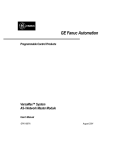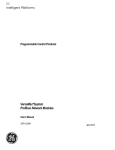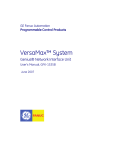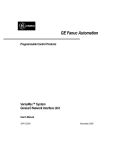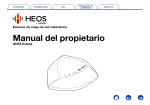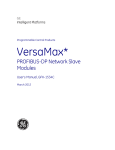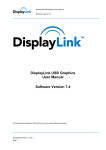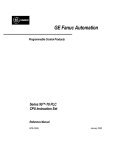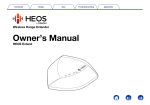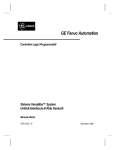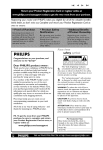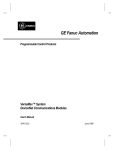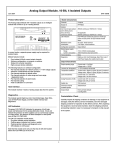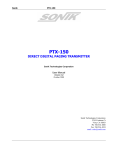Download VersaMax System AS-i Network Master Module User`s Manual, GFK
Transcript
GE Intelligent Platforms Programmable Control Products VersaMax* System AS-i Network Master Module User's Manual GFK-1697A February 2010 GFL-002 Warnings, Cautions, and Notes as Used in this Publication Warning Warning notices are used in this publication to emphasize that hazardous voltages, currents, temperatures, or other conditions that could cause personal injury exist in this equipment or may be associated with its use. In situations where inattention could cause either personal injury or damage to equipment, a Warning notice is used. Caution Caution notices are used where equipment might be damaged if care is not taken. Note: Notes merely call attention to information that is especially significant to understanding and operating the equipment. This document is based on information available at the time of its publication. While efforts have been made to be accurate, the information contained herein does not purport to cover all details or variations in hardware or software, nor to provide for every possible contingency in connection with installation, operation, or maintenance. Features may be described herein which are not present in all hardware and software systems. GE Intelligent Platforms assumes no obligation of notice to holders of this document with respect to changes subsequently made. GE Intelligent Platforms makes no representation or warranty, expressed, implied, or statutory with respect to, and assumes no responsibility for the accuracy, completeness, sufficiency, or usefulness of the information contained herein. No warranties of merchantability or fitness for purpose shall apply. * indicates a trademark of GE Intelligent Platforms, Inc. and/or its affiliates. All other trademarks are the property of their respective owners. ©Copyright 2010 GE Intelligent Platforms, Inc. All Rights Reserved Contact Information If you purchased this product through an Authorized Channel Partner, please contact the seller directly. General Contact Information Online technical support and GlobalCare http://www.ge-ip.com/support 1H2 Additional information http://www.ge-ip.com/ 3H Solution Provider [email protected] 4H Technical Support If you have technical problems that cannot be resolved with the information in this guide, please contact us by telephone or email, or on the web at www.ge-ip.com/support 5H Americas Online Technical Support www.ge-ip.com/support 6H7 Phone 1-800-433-2682 International Americas Direct Dial 1-780-420-2010 (if toll free 800 option is unavailable) Technical Support Email [email protected] 8H9 Customer Care Email Primary language of support [email protected] 10H English Europe, the Middle East, and Africa Online Technical Support www.ge-ip.com/support 12H3 Phone +800-1-433-2682 EMEA Direct Dial +352-26-722-780 (if toll free 800 option is unavailable or if dialing from a mobile telephone) Technical Support Email [email protected] 14H5 Customer Care Email Primary languages of support [email protected] 16H7 English, French, German, Italian, Czech, Spanish Asia Pacific Online Technical Support www.ge-ip.com/support Phone 18H9 +86-400-820-8208 +86-21-3217-4826 (India, Indonesia, and Pakistan) Technical Support Email [email protected] (China) 20H1 [email protected] (Japan) 2H3 [email protected] (remaining Asia customers) 24H5 Customer Care Email [email protected] 26H7 [email protected] (China) 28H Contents Chapter 1 Introduction............................................................................................ 1-1 Other VersaMax Manuals.................................................................................... 1-2 The VersaMax Family of Products.................................................................... 1-3 The VersaMax AS-Interface Network Master Module.......................................... 1-4 VersaMax Applications for the AS-i Network Master Module.............................. 1-5 General Overview of AS-Interface Fieldbus......................................................... 1-6 Power Supply Requirements................................................................................ 1-7 Module Description ............................................................................................. 1-8 The Communications Carrier ............................................................................. 1-10 VersaMax General Product Specifications ......................................................... 1-11 Chapter 2 Hardware Installation............................................................................ 2-1 Preinstallation Check........................................................................................... 2-2 DIN Rail and Panel Mounting ............................................................................. 2-3 Installing the Communications Carrier on the DIN Rail ....................................... 2-4 Installing the AS-i Master Module on the Carrier ................................................. 2-6 Installing the Communications Cable................................................................... 2-7 Module LEDs...................................................................................................... 2-9 CE Mark Installation Requirements ................................................................... 2-10 Chapter 3 Configuration ......................................................................................... 3-1 Configuration Steps............................................................................................. 3-2 VersaMax Hardware Configuration ..................................................................... 3-3 Slave Configuration ............................................................................................ 3-5 AS-i Network Master Configuration .................................................................... 3-6 Protected Mode Operation ................................................................................... 3-9 Autoprogramming............................................................................................. 3-10 Chapter 4 Data Communications ............................................................................ 4-1 Data Exchange on the AS-i Network.................................................................... 4-2 Data Exchange between the AS-i Master and the CPU or NIU ............................. 4-3 Input Data Format ............................................................................................... 4-4 Output Data Format............................................................................................. 4-6 Slave I/O Data Formats ....................................................................................... 4-9 Data Summary .................................................................................................. 4-11 Appendix A GFK-1697A Configuration Worksheet ......................................................................A-1 v Chapter Introduction 1 This manual describes installation and operation of the VersaMax® AS-Interface Master Module. Chapter 1 is a basic introduction. Module and cable Installation procedures are described in chapter 2. Module Configuration is described in chapter 3. Chapter 4 explains how the AS-i Network Master module operates as an interface between the AS-i Network and a VersaMax PLC CPU or VersaMax NIU module. This chapter also describes the formats of the Data Communications between the AS-i Network Master and the CPU or NIU. GFK-1697A 1-1 1 Other VersaMax Manuals The manuals listed below provide additional information about the VersaMax system and specific modules that may be used with the VersaMax AS-i Network Master module. VersaMax Modules, Power Supplies, and Carriers User’s Manual (catalog number GFK1504). Describes the many VersaMax I/O and option modules, power supplies, and carriers. This manual also provides detailed system installation instructions. VersaMax PLC User’s Manual (catalog number GFK-1503). Describes the installation and operation of the VersaMax CPU. VersaMax Ethernet Network Interface Unit User’s Manual (catalog number GFK-1860). Describes the installation and operation of the Ethernet Network Interface Unit module. Remote I/O Manager User’s Guide (catalog number GFK-1847). Gives step-by-step instructions for using the Remote I/O Manager configuration software. VersaMax System DeviceNet Communications Modules User’s Manual (catalog number GFK1533). Describes the installation, configuration, and operation of the DeviceNet NIU and Network Control Modules. VersaMax System Profibus Network Modules User’s Manual (catalog number GFK-1534). Describes the installation, configuration, and operation of the Profibus NIU and network slave modules. VersaMax System Genius Network Interface Unit User’s Manual (catalog number GFK-1535). Describes the installation, configuration, and operation of the Genius NIU. Additional Information about AS-Interface Specifications are provided in Actuator Sensor Interface (AS-Interface) Complete Specification, from the AS-International Association. For detailed information about AS-Interface, please visit the AS-International Association homepage at: www.as-interface.com 1-2 VersaMax™ System AS-i Network Master Module User's Manual – August 2001 GFK-1697A 1 The VersaMax Family of Products The VersaMax family of products provides universally-distributed I/O that spans PLC and PC-based architectures. Designed for industrial and commercial automation, VersaMax I/O provides a common, flexible I/O structure for local and remote control applications. VersaMax PLCs provide big-PLC power with a full range of I/O and option modules. VersaMax I/O Stations with Network Interface Modules make it possible to add the flexibility of VersaMax I/O to other types of networks. VersaMax meets UL, CUL, CE, Class1 Zone 2 and Class I Division 2 requirements. As a scaleable automation solution, VersaMax I/O combines compactness and modularity for greater ease of use. The 70-mm depth and small footprint of VersaMax I/O enables easy, convenient mounting as well as space-saving benefits. Modules can accommodate up to 32 points of I/O each. The compact, modular VersaMax products feature DIN-rail mounting with up to eight I/O and option modules per “rack” and up to 8 racks per VersaMax PLC or VersaMax I/O Station system. Expansion racks can be located up to 750 meters from the main VersaMax PLC or VersaMax I/O Station rack. Expansion racks can include any VersaMax I/O, option, or communications module. VersaMax provides automatic addressing that can eliminate traditional configuration and the need for hand-held devices. Multiple field wiring termination options provide support for two, three, and four-wire devices. For faster equipment repair and shorter Mean-Time-To-Repair, the hot insertion feature enables addition and replacement of I/O modules while a machine or process is running and without affecting field wiring. GFK-1697A Chapter 1 Introduction 1-3 1 The VersaMax AS-Interface Network Master Module The VersaMax AS-Interface Network Master module (IC200BEM104) can be used to interface a VersaMax PLC or I/O station NIU to an AS-i network. It conforms to the AS-Interface Specification for the master AS-Interface protocol. VersaMax PLC CPU power supply Optional booster power supply ASi Network Master Module The AS-i Network Master module allows the VersaMax PLC or I/O Station to exchange data with up to 31 slave addresses on the network. Module Locations in the System The AS-Interface Network Master module can be located in the main rack (rack 0) of a VersaMax PLC or I/O Station as shown above. It can also be located in any expansion rack in a single-ended expansion or multiple-rack system. See the CPU or NIU Users Manual for your system for detailed information about expansion systems. Single-ended Expansion System Multiple-rack Expansion System VersaMax PLC or I/O Station Main Rack VersaMax PLC or I/O Station Main Rack ETM PS PS CPU/NIU CPU/NIU 1M VersaMax ExpansionRack 1 VersaMax Expansion Rack PS PS up to 750M ERM ERM VersaMax ExpansionRack 7 PS Terminator Plug ERM In a CPU system, the sweep time impact of any module depends on whether it is located in the main rack or in an expansion rack. For fastest response times, the module should be located in the main rack. 1-4 VersaMax™ System AS-i Network Master Module User's Manual – August 2001 GFK-1697A 1 VersaMax Applications for the AS-i Network Master Module The AS-Interface Network Master module allows the VersaMax PLC CPU or the VersaMax I/O Station NIU to exchange input and output data with slave devices. In both of the following examples, the AS-i Network Master is located in the expansion rack of a Single-ended Expansion system. VersaMax I/O Station with an AS-i Network Master Module In a VersaMax PLC system, the application program running in the CPU processes slave input data and provides appropriate slave output data. CPU VersaMax PLC Main Rack VersaMax Expansion Rack AS-interface Network Master Module AS-interface Network AS-i Slaves VersaMax I/O Station with an AS-i Network Master Module In a VersaMax I/O Station, the NIU module does not process the AS-i data directly. The NIU is a communications module that exchanges data with the host device that controls the overall system. It is that host device that processes the AS-i data. VersaMax I/O Station Main Rack NIU System Host Field Bus (eg: Profibus) VersaMax Expansion Rack AS-interface Network Master Module AS-interface Network AS-i Slaves GFK-1697A Chapter 1 Introduction 1-5 1 General Overview of AS-Interface Fieldbus Actuator Sensor Interface (AS-i) is a bit-level fieldbus used to network low-level sensors and actuators. It is a simple connection system for the process level in automation systems. Depending on the AS-i version of the connected slaves, up to 31 or 62 I/O devices can be connected to an AS-i network. The slaves are controlled by one master device. The VersaMax AS-i Network Master operates as the single master on the network. The VersaMax AS-i Network Master module complies with the AS-Interface Version 2.1, so its network can have a maximum of 31 slave devices. AS-i devices can range from simple slave devices with up to 4 inputs and/or 4 outputs to “smart” sensors and actuators. The VersaMax ASI-i Network Interface module reads 124 individual input bits from slave devices to the CPU or NIU, and provides 124 individual output bits from the PLC CPU or system host for slave devices. In systems that support the use of 62 slaves, up to 248 individual input bits and 186 individual output bits can be read and controlled. Network Cycle Time The AS-i Master module communicates with the slaves by polling the devices in turn. Communications at the network are set at 166.6 Kbits/second by the ASInterface Specification. With 31 devices on the network, the network cycle time is 5ms. If there are fewer devices on the network, the cycle time on the network is shorter. In a system with 62 devices on the network, the cycle time is 10ms. 1-6 VersaMax™ System AS-i Network Master Module User's Manual – August 2001 GFK-1697A 1 Power Supply Requirements The AS-i Network Master consumes 350mA at 5 volts from the VersaMax power supply. Depending on the power consumption of the modules in the rack, backplane power for the AS-i Network Master module may be provided by the rack power supply on the CPU/ NIU (or Expansion module in an Expansion rack), or from a booster supply as shown below. When a booster power supply is used, the AC or DC Power Supply on the CPU/NIU/expansion module and the Power Supply on the Booster Carrier must share the same user power supply. The VersaMax power supply only provides backplane power for the module. It does not provide power for the AS-i Network. The network needs a special AS-i power supply, which provides DC power via the network cable. VersaMax CPU, NIU, or Expansion Module optional booster power supply rack power supply ASi Network Master Module User Power Supply AS-interface Network As-i Network power supply Slave Devices GFK-1697A Chapter 1 Introduction 1-7 1 Module Description The AS-i Network Master is a standard-size VersaMax module. It mounts on a special type of carrier that is used for communications modules. The AS-i Network Master provides a network connector, LEDs, a mode-select pushbutton, and a special display window that shows the AS-i Network communications status. IC200BEM104 LEDs OK PROT FLT NTERFACE APF NETWORK MASTER Mode Select Pushbutton Display Window 1-8 Network Connector MODE STORE LEDs Four LEDs indicate whether: the module power is present the module is in Protected Mode or Configuration Mode. there are network configuration errors. there is power on the AS-i network. Network Connector The 5-pin removable screw terminal connects to the AS-interface Network. Incoming cable uses the line 1 connections and outgoing cable uses the line 2 connections. An internal connection between the corresponding + and - terminals for line1 and line 2 supports a maximum through current of 3 Amps. Display The display shows slave addresses and status. MODE / STORE Pushbutton The MODE/STORE pushbutton is used to switch between Configuration Mode and Protected Mode or to store a network configuration to the AS-i Network Master module. VersaMax™ System AS-i Network Master Module User's Manual – August 2001 GFK-1697A 1 As-i Network Master Module Specifications Length of %I %Q %AI %AQ 160 Bits (20 Bytes) 160 Bits (20 Bytes) 0 0 Address range of slaves 1-31 Network Address of AS-i Network Interface Module None required, module is the master device. Max. number of slaves 31 Max. data per slave 4 input bits and 4 output bits Isolation: Network to Frame Ground AS-i Network to Backplane 50 VAC continuous, 500 VAC for 1 minute to be defined later LEDs OK, PROT, FLT, APF, 2x 7-segment displays Display Shows slave status Power consumption from VersaMax power supply 350 mA max @ 5 Volts Network data rate, per AS-i Specification 166.6 Kbits/second Network topology Tree structure Maximum bus length, including all cable sections 100 meters without repeaters 300 meters with 2 repeaters Medium Maximum cycle time Messaging Unshielded 2-wire cable for data and power. 5ms with 31 slaves Cyclic polling Termination Required Max. current between line 1 and 2 Module configuration None 3 Amps AS-i Network Master module is included in the system CPU/NIU hardware configuration Slave configuration Slaves are assigned network addresses with hand-held device Configuration mode, Protected mode Operating modes AS-Interface Protocol Compliance The AS-Interface Network Master module complies with the AS-interface Specification 2.1 and supports M0 profile on the network. M0 profile supports 31 slaves and offers basic I/O service, but does not provide explicit messaging between the master and the slaves on the network. GFK-1697A Chapter 1 Introduction 1-9 1 The Communications Carrier The AS-i Network Master module installs on a Communications Carrier (catalog number IC200CHS006). The Communications Carrier provides mounting and backplane communications for the module. 66.8mm (2.63in) 133.4mm (5.25in) IC200CHS006 COMMUNICATIONS CARRIER IND CONT EQ FOR HAZ LOC CLASS I DIV 2 GROUPS ABCD Ambient 60C CLASS 1 ZONE 2 GROUP IIC Ex nA IIC 0C <To<60C Ex nV II Demko No. 98Y.125014 MADE IN USA Din Rail Mounting The carrier snaps easily onto a 7.5mm X 35mm DIN rail. The DIN rail must be electrically grounded to provide EMC protection. The rail must have a conductive (unpainted) corrosion-resistant finish. For applications requiring maximum resistance to mechanical vibration and shock, the carrier must also be panel-mounted. Features 1-10 Compatible with all VersaMax fieldbus communications modules. Fast DIN-rail mounting. Can be located in any “slot”. Module latch hole for securely fastening the module to the carrier. VersaMax™ System AS-i Network Master Module User's Manual – August 2001 GFK-1697A 1 VersaMax General Product Specifications VersaMax products should be installed and used in conformance with productspecific guidelines as well as the following specifications: Environmental Vibration\ Shock\ Operating Temp. IEC68-2-6 IEC68-2-27 Storage Temp. Humidity Enclosure Protection IEC529 EMC Emission Radiated, Conducted CISPR 11/EN 55011 CISPR 22/EN 55022 FCC 47 CFR 15 EMC Immunity Electrostatic Discharge RF Susceptibility EN 61000-4-2 EN 61000-4-3 ENV 50140/ENV 50204 Fast Transient Burst Surge Withstand EN 61000-4-4 ANSI/IEEE C37.90a IEC255-4 EN 61000-4-5 Conducted RF EN 61000-4-6 Isolation Dielectric Withstand UL508, UL840, IEC664 Power Supply Input Dips, Variations EN 61000-4-11 GFK-1697A Chapter 1 Introduction 1G @57-150Hz, 0.012in p--p @10-57Hz 15G, 11ms 0 deg C to +60 deg C ambient -40 deg C to +60 deg C ambient for I/O carriers, interposing I/O terminals, and auxiliary I/O terminals -40 deg C to +85 deg C 5% to 95%, noncondensing Steel cabinet per IP54: protection from dust & splashing water Industrial Scientific & Medical Equipment (Group 1, Class A) Information Technology Equipment (Class A) referred to as FCC part 15, Radio Devices (Class A) 8KV Air, 4KV Contact 10Vrms /m, 80Mhz to 1000Mhz, 80% AM 10Vrms/m, 900MHz +/-5MHZ 100%AM with 200Hz square wave 2KV: power supplies, 1KV: I/O, communication Damped Oscillatory Wave: 2.5KV: power supplies, I/O [12V-240V] Damped Oscillatory Wave: Class II, power supplies, I/O [12V-240V] 2 kV cm(P/S); 1 kV cm (I/O and communication modules) 10Vrms, 0.15 to 80Mhz, 80%AM 1.5KV for modules rated from 51V to 250V During Operation: Dips to 30% and 100%, Variation for AC +/-10%, Variation for DC +/-20% 1-11 Hardware Installation Chapter 2 This section gives basic installation instructions. For more information about system installation, please refer to the VersaMax Modules, Power Supplies, and Carriers Manual, GFK-1504. This chapter describes: GFK-1697A The preinstallation check you should perform on new modules. DIN rail and Panel mounting procedures. Installing the Communications Carrier on the DIN rail Installing the AS-i Network Master module on the carrier Installing the communications cable CE Mark installation requirements 2-1 2 Preinstallation Check Carefully inspect all shipping containers for damage. If any equipment is damaged, notify the delivery service immediately. Save the damaged shipping container for inspection by the delivery service. After unpacking the equipment, record all serial numbers. Save the shipping containers and packing material in case it is necessary to transport or ship any part of the system. Static Protection The module has CMOS components that are susceptible to static damage. Use proper static prevention techniques when handling this module. Conformance to Standards Before installing VersaMax products in situations where compliance to standards or directives from the Federal Communications Commission, the Canadian Department of Communications, or the European Union is necessary please refer to GE’s Installation Requirements for Conformance to Standards, GFK-1179. 2-2 VersaMax™ System AS-i Interface Master Module User's Manual – August 2001 GFK-1697A 2 DIN Rail and Panel Mounting Each rack in a VersaMax PLC or VersaMax I/O Station must be installed on a single section of 7.5mm X 35mm DIN rail, 1mm thick. Steel DIN rail is recommended. “Rack” is the term used for a CPU, NIU, or Expansion Receiver, plus up to 8 physically-connected I/O carriers. The first rack in a system is called Rack 0. If there are multiple expansion racks, Rack 0 also includes an Expansion Transmitter module installed in the leftmost position, before the CPU or NIU. The DIN rail used in a VersaMax installation must be electrically grounded to provide EMC protection. The rail must have a conductive (unpainted) corrosionresistant finish. DIN rails compliant with DIN EN50022 are preferred. For vibration resistance, the DIN rail should be installed on a panel using screws spaced approximately 5.24cm (6 inches) apart. DIN-rail clamps (available as part number IC200ACC313) can also be installed at both ends of the station to lock the modules in position. For applications requiring maximum resistance to mechanical vibration and shock, the DIN-rail-mounted carriers should also be mounted on the panel. Panel mount holes can be located on the panel by using the carrier as a template, or by following the dimensions shown in appendix A. Pre-drill the mounting holes and install the carriers using M3.5 (#6) screws. Hole for Optional Panel-Mounting GFK-1697A Chapter 2 Hardware Installation 2-3 2 Installing the Communications Carrier on the DIN Rail The AS-i Network Master module mounts on a Communications Carrier. Before installing the module on the carrier, the carrier must be installed on the DIN rail. 1. The Communications Carrier snaps easily onto the DIN rail. No tools are required for mounting or grounding to the rail. 2. Slide the carrier along the DIN rail to the other modules until the connector engages. Removing the Communications Carrier from the DIN Rail 2-4 1. Turn off power to the power supply. 2. (If the Communications Carrier is attached to the panel with a screw) remove the Network Communications Module. Remove the panel-mount screw. 3. Slide the carrier along the DIN rail away from the other modules until the connector disengages. 4. With a small flathead screwdriver, pull the DIN rail latch tab outward while tilting the other end of the module down to disengage it from the DIN rail. VersaMax™ System AS-i Interface Master Module User's Manual – August 2001 GFK-1697A 2 Joining Carriers on the DIN Rail Before joining module carriers to a CPU, NIU, or ERM, remove the connector cover on the righthand side of the CPU, NIU, or ERM. Do not discard this cover; you will need to install it on the last carrier. Connector Cover Slide carriers along the DIN rail to engage the connectors in the sides of adjacent carriers. To avoid damaging connector pins, do not force or slam carriers together. Install the connector cover that was removed over the connector on the last carrier to protect the connector pins and to provide compliance with standards. Connector Cover GFK-1697A Chapter 2 Hardware Installation 2-5 2 Installing the AS-i Master Module on the Carrier NOTE System power must be turned off when installing or removing the AS-i Master module. Power-cycling should be done by switching the main power going into the power-supply. DO NOT hot insert or extract the VersaMax power supply on the CPU or NIU to power-down or power-up the system. The latch on the module must be in the unlocked position as illustrated to install it on the Communications Carrier. Align the module and press it straight down onto the carrier, seating it fully. Turn the latch to the locked position to secure the module to the top of the carrier. 2-6 VersaMax™ System AS-i Interface Master Module User's Manual – August 2001 GFK-1697A 2 Installing the Communications Cable The AS-i Network Master module has a 5-pin removable box-style connector to attach the AS-interface Network cable. The network uses a 2-wire parallel cable. Connect the incoming cable using the line 1 pins and an outgoing cable using the line 2 pins. An internal connection between the corresponding + and - terminals is provided between line1 and line 2. Internal connection supports a maximum through-current of 3 Amps. Connector Pin Assignments The connector pin assignments are shown in the following table: Pin Wire * Signal 1 brown AS-i + (line 1) 2 blue AS-i - (line 1) 3 NC 4 brown AS-i + (line 2) 5 blue AS-i - (line 2) * if yellow cable AS-i Network Wiring For network wiring, rubberized 2-wire cable (yellow cable; 2x1.5mm2) allows simple and fast installation. 10mm 4.0mm 6.5mm The contact blades of the slave devices easily penetrate the rubber jacket and contact the wires of the cable. It is possible to remove a device without damage; the cable is “self healing”. Shielding and twisting of the cable is not necessary. The AS-i internet site (www.as-interface.com) provides more information about network cables. GFK-1697A Chapter 2 Hardware Installation 2-7 2 Bus Power Supply and Grounding The AS-i network requires a special AS-i power supply that will not affect network communications. If slave devices are connected on the side opposite the power supply, as shown below, the current through the master module must not exceed 3 Amps. PLC AS-i Slave CPU AS-i Master AS-i Power supply AS-i Slaves 3 A max. Power for the Network Master module itself comes from the VersaMax power supply. The AS-i Network Master module must be included in the system's total power consumption calculation. 2-8 VersaMax™ System AS-i Interface Master Module User's Manual – August 2001 GFK-1697A 2 Module LEDs The table below describes the meanings of the Master’s LED states. OK Steady Green OK PROT FLT Flashing Green APF Steady Amber PROT FLT Flashing Amber A self-diagnostic error is present. Off Steady Green Backplane power to the module is not present. the AS-Interface module is in Protected Mode. Flashing Green the module was unable to enter the requested mode. Off Steady Red the module is in Configuration Mode. the AS-Interface module has detected a configuration error on the AS-Interface network. a configured slave does not exist on the network (missing slave). a slave is detected on the network that is not part of the currently stored configuration (extra slave). a configured slave is detected, but its I/O configuration does not match the stored I/O configuration for that slave address. (wrong slave) a configured slave has failed and AUTOPROG is enabled (this is default setting). This shows that Autoprogramming is possible and enabled. See chapter 3 for information about Autoprogramming. Flashing Red APF Off No configuration fault Steady Red the voltage being supplied by the AS-Interface power supply is too low or has failed. AS-i Power ok Off GFK-1697A the module has no faults, powerup diagnostics have passed, and the module is communicating with the CPU or NIU. the module is in Boot Mode or the module firmware is being updated. module is not communicating to the CPU or NIU. Chapter 2 Hardware Installation 2-9 2 CE Mark Installation Requirements The following requirements for surge, electrostatic discharge (ESD), and fast transient burst (FTB) protection must be met for applications that require CE Mark listing: 2-10 The VersaMax PLC or I/O Station is considered to be open equipment and should therefore be installed in an enclosure (IP54). This equipment is intended for use in typical industrial environments that utilize anti-static materials such as concrete or wood flooring. If the equipment is used in an environment that contains static material, such as carpets, personnel should discharge themselves by touching a safely grounded surface before accessing the equipment. If the AC mains are used to provide power for I/O, these lines should be suppressed prior to distribution to the I/O so that immunity levels for the I/O are not exceeded. Suppression for the AC I/O power can be made using line-rated MOVs that are connected line-to-line, as well as line-to-ground. A good high-frequency ground connection must be made to the line-to-ground MOVs. AC or DC power sources less than 50V are assumed to be derived locally from the AC mains. The length of the wires between these power sources and the PLC should be less than a maximum of approximately 10 meters. Installation must be indoors with primary facility surge protection on the incoming AC power lines. In the presence of noise, serial communications could be interrupted. VersaMax™ System AS-i Interface Master Module User's Manual – August 2001 GFK-1697A Configuration Chapter 3 Configuration is the process of setting up the operation of the system devices. Refer to the following topics: GFK-1697A Configuration Steps describes the three basic steps that must be completed. VersaMax Hardware Configuration explains how to include the module in the PLC or I/O Station configuration. Slave Configuration describes the process of assigning Network Addresses. AS-i Network Master Configuration describes how the AS-i Master generates a configuration, and explains how to save the configuration when it is correct. Protected Mode Operation explains how to begin normal operation. Autoprogramming explains how you can replace a configured slave device without placing the Master module in Configuration mode. 3-1 3 Configuration Steps There are three basic setup procedures that must be completed: VersaMax Hardware Configuration: this adds the VersaMax communication carrier and the AS-i Network Master module to the VersaMax PLC or VersaMax Network Interface Unit (NIU) hardware configuration. It establishes I/O references and data lengths for the AS-i network’s input and output data. This step can be performed with the AS-i Network Master module already installed in the PLC or I/O Station as described in chapter 2. Slave Configuration: this assigns each slave a Network Address. Slave devices must not be connected from the network to perform this step. AS-i Network Master Configuration: after connecting the slaves to the network, with the Network Master module already operating, this step sets up communications between the AS-i Master and the slave devices that are present on the network. In addition, the AS-i Network Master module’s Master Control Bit must be set to 1 by the application to begin exchanging data with the slaves on the AS-i Network. For more information, see chapter 4. 3-2 VersaMax™ System AS-i Interface Master Module User's Manual – August 2001 GFK-1697A 3 VersaMax Hardware Configuration The AS-i Network Master module and Communications Carrier must be included in the hardware configuration of the VersaMax PLC CPU or, if it is located in an I/O Station, the configuration of the VersaMax Network Interface Unit that controls the I/O Station. This step can be done with the module installed in the PLC or I/O Station as instructed in chapter 2. It must be done before the AS-i Network Master can exchange data with the CPU or NIU. Both the VersaMax PLC CPU manual and the individual NIU manuals include general instructions for completing the PLC or I/O Station configuration. Specific instructions for adding a Communications Carrier and AS-i Network Master module using the configuration software are explained below. Entering the Module Location and Type To add the AS-i Network Interface module to the hardware configuration, select the Hardware configuration menu to define the module characteristics: GFK-1697A Location (carrier/module). The AS-i Network Master can be placed in any module location in the system. In the selected location, insert a Communications Carrier IC200CHS006. On that Carrier, insert a Generic Communication Module GENERIC_COMM: Chapter 3 Configuration 3-3 3 Entering the Module Characteristics After adding the Generic Communication Module, enter the parameters in the Parameter Dialog box: Settings Tab: 1. Select the Reference Address and Length %I and %Q data. The Reference Addresses can be selected to suit the application. Note that the first 36 bits of inputs and outputs will be used for status and control data as explained in chapter 4. That means the first slave input data and the first slave output data will actually begin at the selected address +37.Refer to chapter 4 for more detailed information about how the data in these references is assigned to status and I/O data. The length for %I and %Q must be 160 bits, regardless of whether all 31 possible slaves are used on the network. 3-4 2. The length of %AI0001 and %AQ0001 (data areas used for analog inputs and analog outputs) must be set to 0. 3. Enter the Module ID: 9 (the complete ID is FFFF9809). Wiring Tab: can be used to enter tags for the different data points. Power Consumption Tab: Enter the power consumption for the Network Master module, which is 350mA. VersaMax™ System AS-i Interface Master Module User's Manual – August 2001 GFK-1697A 3 Slave Configuration This step must be done before connecting the individual slaves to the AS-i Network. Each slave device on the AS-i Network must have a unique Network Address that identifies it during communications. Before a slave device can be used on the network, its Network Address must be explicitly assigned. When adding multiple slaves to the network, slave addresses are assigned as described below. If the system is already operating and the Network Master is in Protected mode, you can replace an existing slave with another of the same type without going through this step. See “Autoprogramming” later in this chapter for more information. Assigning Network Addresses to Slave Devices in Configuration Mode Before connecting the slaves to the network, assign their Network Addresses using a hand held addressing unit. The network address will be saved electronically in the EEPROM of the individual slave. Slave Device Hand-held Addressing Unit To assign the slave addresses: GFK-1697A 1. Connect a slave to the hand held addressing unit. 2. The display of the addressing unit shows the actual stored address of the slave device if you press the ADR button. You may change the address of the slave up or down by pressing the arrow keys. 3. Press the PRG button and the selected address will be stored to the slave device. 4. Before you install the slave device on the AS-i Network, disconnect the hand held addressing unit. Chapter 3 Configuration 3-5 3 AS-i Network Master Configuration After assigning the Network Address of each slave, connect the slaves and the network power supply to the network. The AS-i Network Master module should also be connected to the network. See chapter 2 for installation instructions. When the AS-i Master module powers up with no stored configuration in memory, it automatically enters Configuration Mode. The module also powers up in Configuration Mode following a change to its firmware version. When the module powers up with a stored configuration in memory, it automatically enters Protected Mode. To place it in Configuration Mode, press the Mode/Store pushbutton. (To protect against unwanted configuration changes, operation of this pushbutton may be disabled using the Master Control bit, as described in chapter 4). In Configuration mode, the Master recognizes all slaves that have a valid network address, and exchanges data with them. This makes it possible to set up and debug the network configuration before saving the configuration to the module’s nonvolatile memory and placing it in Protected Mode. LED Indications in Configuration Mode In Configuration Mode, the LEDs on the AS-i Network Master should look like this: OK PROT FLT RUN mode, AS-i Network Master module is communicating with the CPU or NIU The AS-i Network Master is in Configuration Mode APF ON 3-6 OFF Flash VersaMax™ System AS-i Interface Master Module User's Manual – August 2001 GFK-1697A 3 Operating in Configuration Mode In Configuration Mode, the Network Master module displays the addresses of slaves on the network and their status, cycling through Network Addresses in sequence. The rightmost character shows the configuration status of each device. For example: GFK-1697A Detected, but not configured slave at Network Address 28A: Configured, but not detected slave at Network Address 28A: The slave at Network Address 28A not mapped to AS-i Master module configuration. The slave at Network Address 28A does not match the saved configuration. Chapter 3 Configuration 3-7 3 Saving the Network Configuration After making any necessary changes so that the devices on the network match the desired setup, the configuration can be saved. The Network Master must be in Configuration Mode to store or change the network configuration. If the present network configuration is correct and the network is connected (the module’s APF LED is off) and you want to save the configuration and go to Protected Mode, press the Mode/Store pushbutton for approximately 5 seconds. When the PROT LED changes to green, the module is in Protected mode. If you don’t want to save the configuration, you can either: go to Protected mode without saving the new configuration (for example, to continue using the previous configuration, or: erase a previously-saved configuration and stay in Configuration mode. Entering Protected Mode without Saving the Network Configuration If you want to place the Network Master in Protected Mode using a previouslysaved configuration instead of the present network configuration, and the network is connected (the module’s APF LED is off), press the Mode/Store pushbutton for less than 5 seconds. Erasing the Saved Configuration and Staying in Configuration Mode If the present network configuration is not correct and you want to erase it and remain in Configuration Mode, disconnect the network cable and press the Mode/Store pushbutton for at least 5 seconds. The Network Master clears the saved network configuration and remains in Configuration Mode. 3-8 VersaMax™ System AS-i Interface Master Module User's Manual – August 2001 GFK-1697A 3 Protected Mode Operation The saved network configuration is used in the Protected mode of operation. In Protected mode, the AS-i Network Master module exchanges I/O data only with the slaves whose network addresses are included in the saved network configuration. If new slaves are added while the AS-i Network Master is in Protected mode, they are not scanned. (If a previously-configured module is replaced with another one of the same type, the AS-i Network automatically configures it and begins exchanging data. See “Autoprogramming” on the next page). Entering Protected Mode 1. If the AS-i Network Master is powered up with a stored configuration in memory, it automatically enters Protected mode. 2. If the AS-i Network Master is in Configuration mode, it can be placed in Protected mode by pressing the Mode/Store pushbutton. (To protect against unwanted configuration changes, operation of this pushbutton may be disabled as described in chapter 4). LED-Status in Protected Mode OK PROT RUN, BEM104 communicating with CPU/NIU Protected Mode FLT APF ON OFF Flash Display Operation in Protected Mode If the AS-i Network Master is in Protected Mode and no errors are detected with the network configuration, the displays are empty. However, if the Master detects a configuration error, the displays indicate the location and type of error. th GFK-1697A Chapter 3 Configuration 4 digit description - Loss of slave + Extra slave / Slave not mapped # Mismatch of slaves 3-9 3 Autoprogramming The Autoprogramming feature of the AS-i Network Master module makes it easy to replace one slave (only) while the system is running in Protected Mode. The AS-i Network Master automatically configures the new slave over the network, assigning it the same network address as the old module (the same function normally performed with a hand-held configuration device). It is not necessary to use a handheld configuration device or to place the AS-i Network Master module in Configuration mode to replace the faulty slave. The new slave must be the same type as the slave being replaced. In addition, it must have the address 0, which is not a valid network address. If the slave being added does not match, or if it already has a configured network address, the NIU displays an error and Autoprogramming does not occur. Using Autoprogramming 1. Remove the faulty device from the AS-Interface network. 2. Connect a new slave device of the same type (with address 0) to the network. When the Network Master module detects a slave with address 0 and just one configured slave is missing, the Network Master module changes to Autoprogramming mode. The display indicates that a slave is missing (23 in this example): The LEDs look like this: OK PROT FLT RUN, Master communicating with CPU or NIU Protected Mode Configuration Error APF ON OFF Flash The Network Master module checks to see if the slave with address 0 has the same I/O-code and ID number as the missing configured slave. If it does, the Network Master configures the address within the slave. It changes the invalid address of 0 to the previously-configured address of the missing slave. If the Network Master module detects more than one slave with the invalid address of 0, this Autoprogramming does not occur. 3-10 VersaMax™ System AS-i Interface Master Module User's Manual – August 2001 GFK-1697A Chapter Data Communications 4 This chapter explains how the AS-i Network Master module operates as an interface between the AS-i Network and a VersaMax PLC CPU or VersaMax NIU module. This chapter also describes the formats of the data exchanged between the AS-i Network Master and the CPU or NIU. GFK-1697A Data exchange on the AS-i Network Data exchange between the AS-i Master and the CPU or NIU Input data format Output data format 4-1 4 Data Exchange on the AS-i Network The AS-i Network Master module operates as the only master on an AS-i network. The network can have up to 31 slaves. The AS-i Network Master communicates with each slave, polling the slaves in the order of their assigned Network Addresses. The AS-i Master first sends slave 1 four bits of output data. AS-i Slaves AS-i Master 1 2 3 The slave replies and sends the AS-i Master four bits of input data. AS-i Slaves AS-i Master 1 2 3 The AS-i Master then exchanges data with the next slave. AS-i Slaves AS-i Master 1 2 3 In Configuration Mode data is exchanged with all detected slaves whereas in Protected Mode only data for configured slaves is exchanged. Communications at the network are set at 166.6 Kbits/second by the AS-Interface Specification. With 31 devices on the network, the network cycle time is 5ms. If there are fewer devices on the network, the cycle time on the network is shorter 4-2 VersaMax™ System AS-i Interface Master Module User's Manual – August 2001 GFK-1697A 4 Data Exchange between the AS-i Master and the CPU or NIU The AS-i Network Master module functions as a completely asynchronous interface between the AS-interface network and a VersaMax PLC CPU or VersaMax NIU in an I/O Station. The application program for a VersaMax PLC or host of the system that controls a VersaMax I/O Station must take into account the independent communications cycles that are transferring the actual slave input and output data. Data Exchanges in a PLC System In a PLC system, the PLC CPU first reads inputs from the AS-i Network Master module as part of its input data sweep. The CPU application program processes the data, then sends output data to the AS-i Master during the same CPU sweep. The output data returned to the AS-i Network Master module therefore reflects any actions taken by the application logic during that CPU sweep. CPU Sweep Data Exchange with AS-i Master Module Cyclic Polling of the AS-i Slaves by the AS-i Master CPU AS-i Master AS-i Slaves VersaMax PLC Data Exchanges in an I/O Station System In a VersaMax I/O Station, there is an additional communications cycle involved, because the I/O Station’s NIU (Network Interface Unit) must also exchange its data over a communications bus with a PC or other host. This extra cycle time can add significantly to the response times in the system. NIU Sweep Data Exchange with As-i Master Module NIU Data Exchange with Host Cyclic Polling of the AS-i Slaves by the AS-i Master Host NIU AS-i Master AS-i Slaves GFK-1697A Chapter 4 Data Communications 4-3 4 Input Data Format The AS-i Network Master module automatically provides 20 bytes (160 bits) of input data to the CPU or NIU. The input data bytes include: 4 bytes of status data for all slaves, 1 byte of data that includes the status of the AS-i Network Master module itself, 16 bytes of input data from the slave devices. The overall structure of this data as provided to the CPU or NIU is shown below. Bytes 1-4 = Slave Status Byte 5, first 4 bits = AS-i Master Status Byte 5, last 4 bits to Byte 20 = Device Inputs Input Data Format Slave Status Bits, Bytes 1-4 The first 4 bytes (32 bits) of the input data are slave status bits. The status bits indicate which slaves are active. There is one status bit for each network address 1 31. The application can check the bit corresponding to an individual network address before to using the slave’s input data. Byte Bit 1 1-8 Description The status for slaves with network addresses 1-8 respectively. 0 = slave is not actively exchanging I/O data 1 = slave is actively exchanging I/O data 2 9-16 Status bits for slaves with Network Addresses 9-16 3 17-24 Status bits for slaves with Network Addresses 17-24 4 25-31 32 4-4 Status bits for slaves with Network Addresses 25-31 Reserved and always 0 VersaMax™ System AS-i Interface Master Module User's Manual – August 2001 GFK-1697A 4 As-i Master Status Data, Byte 5 (Bits 33-36) Input bits 33-36 (the first 4 bits of byte 5) indicate the current status of the AS-i Network Master Module. The application program can check these bits to monitor the status of the master and of the AS-i bus. Note: Because the I/O scan with the CPU or NIU is not synchronous with the AS-i Master updating the Status Bits, it is possible for the application to miss very brief changes of the Status Bits. Byte 5 Bit 33 34 34 36 37-40 Meaning AS-i Power supply status: 0= AS-i Power supply is OK 1= Voltage at the AS-i Power supply is to low or failed AS-i Network Master module configuration status: 0= No configuration fault 1= Master has detected a configuration fault AS-i Module Configuration or Protected mode: 0= Configuration mode 1= Protected mode Reserved and always 0. Input data area corresponds to device 1 on the network. See below. Slave Input Data, Byte 5 (Bits 37-40) through Byte 20 The slave input data itself consists of four bits of input data for each of Network Addresses. If a network address is used for an output device, or not used, the contents of the corresponding 4 bits are not meaningful. Byte 5 6 7 8 9 to 20 GFK-1697A Bit 33-36 Meaning As-i Network Master Status Bits. See above 37-40 41-44 45-48 49-52 53-56 57-60 61-64 65-160 Input Input Input Input Input Input Input Input data area corresponding to Network Address 1 data area corresponding to Network Address 2 data area corresponding to Network Address 3 data area corresponding to Network Address 4 data area corresponding to Network Address 5 data area corresponding to Network Address 6 data area corresponding to Network Address 7 data area corresponding to Network Address 8 to 31 Chapter 4 Data Communications 4-5 4 Output Data Format The As-i Network Master module receives 20 bytes (160 bits) of output data from the CPU. The format of the output data is shown below. Bytes 1 to 4 (bits 1-24) are reserved (not used). Bit 1 of byte 5 is the Master Control Bit. The CPU or system host (via the NIU) can use this bit to control the operation of the Network Master module, as described on the next page. Bytes 1- 4 = Not Used Byte 5, bit 1 = AS-i Master Control Bit Byte 5 last 4 bits, to Byte 20 = Slave Outputs Output Data Format The Output Data contains 4 bits of data for each of the 31 potential network Addresses, beginning with the last 4 bits of byte 5. Output Data Descriptions Byte Bit 5 1 6 7 8 9-20 4-6 Meaning Master Control Bit. Setting or clearing this bit enables or disables data exchange between the AS-i Master and the CPU/NIU. This bit also controls operation of the MODE/STORE button. 0 no data exchange MODE/STORE button is enabled, outputs are reset. 1 in protected mode: data exchange with CPU or NIU in configuration mode: no data exchange with CPU MODE/STORE button is disabled. 2-4 Reserved and must be set to 0. 5-8 The output values for the slave at Network Address 1 1-4 The output values for the slave at Network Address 2 5-8 The output values for the slave at Network Address 3 1-4 The output values for the slave at Network Address 4 5-8 The output values for the slave at Network Address 5 1-4 The output values for the slave at Network Address 6 5-8 The output values for the slave at Network Address 7 1-8 The output values for the slaves at Network Addresses 8-31 VersaMax™ System AS-i Interface Master Module User's Manual – August 2001 GFK-1697A 4 Using the Master Control Bit The Master Control Bit allows the application in the PLC CPU or system host to control the AS-i Network data. The Master Control Bit can be set by the application program or from the programmer. This can be done when the AS-i Network Master module is in either Configuration mode or Protected mode. The CPU or NIU can only read slave inputs and control slave outputs when the Master Control Bit is 1. If the CPU stops with outputs disabled, the Master Control Bit is reset (with all other data). The application needs to set this bit to 1 to restart exchanging actual slave input and output data. Master Control Bit is 0 When the Master Control Bit is 0, the AS-i Network Master module continues polling the slaves. However, instead of providing actual input and output data, the AS-i Network Master sets all data to 0: Input Data: The AS-i Network Master sets all inputs to the CPU or NIU to 0. Output Data: The AS-i Network Master sets all outputs to slaves to 0. Mode/Store button: can be used to change the AS-i Network Master’s operating mode and to store an AS-i Network configuration to the Network Master module. Master Control Bit is 1 When the Master Control Bit is 1, the AS-i Network Master module depend on whether the AS-i Network Master module sends slave input data to the CPU or NIU, and sends application output data to the slaves: Input Data: The AS-i Network Master sends slave inputs to the CPU or NIU. Output Data: The AS-i Network Master sends CPU/NIU output data to the slaves. Mode/Store button: disabled. No configuration can be stored to the Network Master and the operating mode cannot be changed. If the AS-i Network Master module is in Configuration mode, it sends output data to all detected slaves. If the AS-i Network Master module is in Protected mode, it sends output data only to slaves that have been included in the presently-saved configuration. GFK-1697A Chapter 4 Data Communications 4-7 4 Output Default Conditions The AS-i Network Master module defaults output states in response to specific conditions. If the AS-i Network Master loses communication with the PLC CPU or NIU module, it sets all AS-i slave output data to 0. It also sets the Master Control Bit to 0. The Master Control Bit must be set to 1 by the application to restart data exchange with the AS-i Network slaves when system communications resume. Output Defaults in a VersaMax PLC System If the AS-i Network Master module is installed in a VersaMax PLC system: if the CPU is set to the Stop mode with outputs disabled, the AS-i Network Master sets all AS-i network output data to 0. It continues sending this output data to the slaves. if the CPU is set to the Stop mode with outputs enabled, the AS-i Network Master holds all AS-i network output data in its last state. It continues sending this output data to the slaves. Output Defaults in an I/O Station If the AS-interface Network Master module is installed in an I/O Station controlled by an NIU, if the NIU loses communication with its network (for example, the Profibus network), the default action of the specific NIU is taken. For example, an autoconfigured VersaMax Profibus NIU sets all discrete outputs to 0. That includes all AS-i network output data, including the Master Control Bit. 4-8 VersaMax™ System AS-i Interface Master Module User's Manual – August 2001 GFK-1697A 4 Slave I/O Data Formats The AS-i network can have up to 31 slaves. As explained on the previous pages, the AS-i Network Master module allocates 4 input bits and 4 output bits of data for each potential slave. Whether or not a slave utilizes all of its input and output bits depends on what type of slave it is. Slaves can be simple I/O modules such as individual actuators and sensors. Slaves can also be “smart” actuators and sensors with integrated AS-i connection. See the two examples below: Example 1: Simple Input Sensor A simple device such as a sensor or actuator used as a slave on the network uses just one of the four input and output bits assigned to that Network Address in the AS-i Network Master module’s memory. In this example, a simple sensor is a network slave assigned to Network Address 14. The sensor uses one input bit and no output bits for Network Address 14. Data for Network Address 14 AS-i Network Sensor 1 Networkaddress 14 GFK-1697A Chapter 4 Data Communications BEM104 BEM104 BEM104 BEM104 Input Bit 1 Input Bit 2 Input Bit 3 Input Bit 4 Address 14 (not used) (not used) (not used) BEM104 BEM104 BEM104 BEM104 Output Bit 1 Output Bit 2 Output Bit 3 Output Bit 4 (not used) (not used) (not used) (not used) Sensor 4-9 4 Example 2: Interface Module for Multiple Sensors Interface modules can make it possible to accommodate more sensors and actuators at one slave address. Depending on the interface module type, up to 4 simple input devices and 4 simple output devices can exchange data via the same slave address. In the next example, an interface module is assigned to Network Address 14. This slave interface module is a 2in/2out device; it is connected to 2 sensors and 2 actuators. This interface module assigns its first 2 bits for use as inputs and its second two bits for use as outputs. For this example, the AS-i Network Master module assigns input and output bits to memory as shown below. The application must account for specific data arrangements required for AS-i network interface modules. AS-i Network Data for Network Address 14 As-i Interface Module SLAVE Sensor 1 Sensor 2 Actuator 1 BEM104 Input Bit 1 BEM104 Input Bit 2 BEM104 Input Bit 3 BEM104 Input Bit 4 Module Bit 1 Module Bit 2 (not used) (not used) BEM104 Output Bit 1 BEM104 Output Bit 2 BEM104 Output Bit 3 BEM104 Output Bit 4 (not used) (not used) Module Output 1 Module Output 2 Sensor 1 Sensor 2 Actuator 1 Actuator 2 Actuator 2 Some interface modules are capable of bi-directional data handling, and can therefore support as many as 4 sensors and 4 actuators. Such a slave would utilize all 4 of its AS-i Network Master module input bits and all 4 of its output bits. 4-10 VersaMax™ System AS-i Interface Master Module User's Manual – August 2001 GFK-1697A 4 Data Summary The table below shows the AS-i Network Master’s input data bytes (left side) and output data bytes (right side). Input Bytes 1 2 3 4 5 6 7 8 9 10 11 12 13 14 15 16 17 18 19 20 GFK-1697A Description Bits 1-8 + status data for devices 1-8 Bits 9-16 + status data for devices 9-16 Bits 17-24 + status data for devices 17-24 Bits 25-31 + status data for devices 25-31 Bit 32 = reserved, always 0 Bit 33 = AS-i power supply status Bit 34 = AS-i Master config status Bit 35 = AS-i Master mode (Conf/Prot) Bit 36 = must be 0 Bits 37-40 = Input data from Slave 1 Bits 41-44 = Input data from Slave 2 Bits 45=48 = Input data from Slave 3 Bits 49-52 = Input data from Slave 4 Bits 53-56 = Input data from Slave 5 Bits 57-60 = Input data from Slave 6 Bits 61-64 = Input data from Slave 7 Bits 65-68 = Input data from Slave 8 Bits 69-72 = Input data from Slave 9 Bits 73-76 = Input data from Slave 10 Bits 77-80 = Input data from Slave 11 Bits 81-84 = Input data from Slave 12 Bits 85-88 = Input data from Slave 13 Bits 89-92 = Input data from Slave 14 Bits 93-96 = Input data from Slave 15 Bits 97-100 = Input data from Slave 16 Bits 101-104 = Input data from Slave 17 Bits 105-108 = Input data from Slave 18 Bits 109-112 = Input data from Slave 19 Bits 113-116 = Input data from Slave 20 Bits 117-120 = Input data from Slave 21 Bits 121-124 = Input data from Slave 22 Bits 125=128 = Input data from Slave 23 Bits 129-132 = Input data from Slave 24 Bits 133-136 = Input data from Slave 25 Bits 137-140 = Input data from Slave 26 Bits 141-144 = Input data from Slave 27 Bits 145-148 = Input data from Slave 28 Bits 149-152 = Input data from Slave 29 Bits 153-156 = Input data from Slave 30 B its 157-160 = Input data from Slave 31 Chapter 4 Data Communications Output Bytes Description 1 2 3 4 Do not use., must be 0 5 Bit 33 = Master Control Bit Bit 34 = must be 0 Bit 35 = must be 0 Bit 36 =must be 0 Bits 37-40 = Output data for Slave 1 Bits 41-44 = Output data for Slave 2 Bits 45=48 = Output data for Slave 3 Bits 49-52 = Output data for Slave 4 Bits 53-56 = Output data for Slave 5 Bits 57-60 = Output data for Slave 6 Bits 61-64 = Output data for Slave 7 Bits 65-68 = Output data for Slave 8 Bits 69-72 = Output data for Slave 9 Bits 73-76 = Output data for Slave 10 Bits 77-80 = Output data for Slave 11 Bits 81-84 = Output data for Slave 12 Bits 85-88 = Output data for Slave 13 Bits 89-92 = Output data for Slave 14 Bits 93-96 = Output data for Slave 15 Bits 97-100 = Output data for Slave 16 Bits 101-104 = Output data for Slave 17 Bits 105-108 = Output data for Slave 18 Bits 109-112 = Output data for Slave 19 Bits 113-116 = Output data for Slave 20 Bits 117-120 = Output data for Slave 21 Bits 121-124 = Output data for Slave 22 Bits 125=128 = Output data for Slave 23 Bits 129-132 = Output data for Slave 24 Bits 133-136 = Output data for Slave 25 Bits 137-140 = Output data for Slave 26 Bits 141-144 = Output data for Slave 27 Bits 145-148 = Output data for Slave 28 Bits 149-152 = Output data for Slave 29 Bits 153-156 = Output data for Slave 30 Bits 157-160 = Output data for Slave 31 6 7 8 9 10 11 12 13 14 15 16 17 18 19 20 4-11 Appendix Configuration Worksheet A A worksheet like the one in this section can be a handy look-up table of device configurations. In the worksheet, the starting %I and %Q address matches the %I and %Q Reference Addresses assigned to the AS-i Network Master module during CPU or NIU configuration. From this starting address, you can determine the corresponding address for each slave’s input status bit. Note that although the first four output bytes (32 output bits) are not used for data, they must not be used for anything else in the program, and must be set to 0. The actual output data for the AS-i module starts at %Q(n+32). GFK-1697A A-1 A Enter starting %I address here → Reference Addresses %I Enter starting %Q %Q address here → A-2 AS-I Master, Input Bits 1 AS-I Master, Output Bits - - - Description Slave 1 status bit Do not use, must be 0 %I 2 - Slave 2 status bit %Q - - Do not use, must be 0 %I 3 - Slave 3 status bit %Q %I %Q 4 - - Do not use, must be 0 Slave 4 status bit Do not use, must be 0 %I 5 - Slave 5 status bit %Q %I 6 - Do not use, must be 0 Slave 6 status bit %Q %I %Q %I 7 8 - Do not use, must be 0 Slave 7 status bit Do not use, must be 0 Slave 8 status bit %Q %I %Q 9 - - Do not use, must be 0 Slave 9 status bit Do not use, must be 0 %I %Q %I %Q 10 11 - - Slave 10 status bit Do not use, must be 0 Slave 11 status bit Do not use, must be 0 %I 12 - Slave 12 status bit %Q %I 13 - Do not use, must be 0 Slave 13 status bit %Q - - Do not use, must be 0 %I %Q %I 14 - Slave 14 status bit Do not use, must be 0 Slave 15 status bit %Q %I - - Do not use, must be 0 Slave 16 status bit - Do not use, must be 0 15 %Q 16 - %I 17 - Slave 17 status bit %Q - - Do not use, must be 0 VersaMax™ System AS-i Interface Master Module User's Manual – August 2001 GFK-1697A A Reference Addresses AS-I Master, Output Bits %I AS-I Master, Input Bits 18 - Slave 18 status bit %Q - - Do not use, must be 0 %I 19 - Slave 19 status bit %Q %I 20 - Do not use, must be 0 Slave 20 status bit %Q %I 21 - Do not use, must be 0 Slave 21 status bit %Q %I 22 - Do not use, must be 0 Slave 22status bit %Q %I 23 - Do not use, must be 0 Slave 23 status bit %Q - - Do not use, must be 0 %I %Q %I %Q 24 25 - - Slave 24 status bit Do not use, must be 0 Slave 25 status bit Do not use, must be 0 %I 26 - Slave 26 status bit %Q %I 27 - Do not use, must be 0 Slave 27 status bit %Q %I 28 - Do not use, must be 0 Slave 28 status bit %Q %I 29 - Do not use, must be 0 Slave 29 status bit %Q %I %Q 30 - - Do not use, must be 0 Slave 30 status bit Do not use, must be 0 %I 31 - Slave 31 status bit %Q - - Do not use, must be 0 %I %Q 32 - Not used, always 0 Do not use must be 0 GFK-1697A - Appendix A Configuration Worksheet Description A-3 A Reference Addresses %I AS-I Master, Input Bits 33 AS-I Master, Output Bits - AS-i Power Supply status %I 34 - AS-i Master config. status %I 35 - AS-i Master mode %I %Q 36 33 Not used, always 0 Master Control Bit 34 35 Not used, must be 0 Not used, must be 0 Not used, must be 0 Input 1 Slave 1 %Q %Q A-4 Description %Q %I 37 36 - %I %I 38 39 - Input 2 Input 3 %I 40 - Input 4 %Q %Q %Q %Q - 37 38 39 40 %I 41 - %I %I 42 43 - %I %Q 44 - 41 Input 4 Output 1 %Q %Q - 42 43 Output 2 Output 3 %Q %I %I 45 46 44 - %I 47 - Input 3 %I 48 - Input 4 %Q %Q - 45 46 Output 1 Output 2 %Q - 47 Output 3 %Q - 48 Output 4 Output 1 Output 2 Output 3 Output 4 Slave 2 Input 1 Input 2 Input 3 Slave 3 Output 4 Input 1 Input 2 VersaMax™ System AS-i Interface Master Module User's Manual – August 2001 GFK-1697A A Reference Addresses %I GFK-1697A AS-I Master, AS-I Master, Input Bits Output Bits 49 - Description Slave 4 Input 1 %I 50 - Input 2 %I 51 - Input 3 %I %Q 52 - 49 Input 4 Output 1 %Q %Q - 50 51 Output 2 Output 3 %Q %I 53 52 - %I %I 54 55 - Input 2 Input 3 %I 56 - Input 4 %Q %Q %Q %Q - 53 54 55 56 %I 57 - %I %I 58 59 - %I %Q 60 - 57 Input 4 Output 1 %Q %Q - 58 59 Output 2 Output 3 %Q %I %I 61 62 60 - %I 63 - Input 3 %I 64 - Input 4 %Q %Q - 61 62 Output 1 Output 2 %Q - 63 Output 3 %Q - 64 Output 4 Appendix A Configuration Worksheet Slave 5 Output 4 Input 1 Output 1 Output 2 Output 3 Output 4 Slave 6 Input 1 Input 2 Input 3 Slave 7 Output 4 Input 1 Input 2 A-5 A Reference Addresses A-6 %I AS-I Master, Input Bits 65 AS-I Master, Output Bits - Description %I 66 - Input 2 %I 47 - Input 3 %I %Q 68 - 65 Input 4 Output 1 %Q %Q - 66 47 Output 2 Output 3 %Q %I 69 68 - %I %I 70 71 - Input 2 Input 3 %I 72 - Input 4 %Q %Q %Q %Q - 69 70 71 72 %I 73 - %I %I 74 75 - %I %Q 76 - 73 Input 4 Output 1 %Q %Q - 74 75 Output 2 Output 3 %Q %I %I 77 78 76 - %I 79 - Input 3 %I 80 - Input 4 %Q %Q - 77 78 Output 1 Output 2 %Q - 79 Output 3 %Q - 80 Output 4 Slave 8 Slave 9 Input 1 Output 4 Input 1 Output 1 Output 2 Output 3 Output 4 Slave 10 Input 1 Input 2 Input 3 Slave 11 Output 4 Input 1 Input 2 VersaMax™ System AS-i Interface Master Module User's Manual – August 2001 GFK-1697A A Reference Addresses GFK-1697A %I AS-I Master, Input Bits 81 AS-I Master, Output Bits Slave 12 - %I 82 %I 83 - %I %Q 84 - 81 Input 4 Output 1 %Q %Q - 82 83 Output 2 Output 3 %Q %I 85 84 - %I %I 86 87 - Input 2 Input 3 %I 88 - Input 4 %Q %Q %Q %Q - 85 86 87 88 %I 89 - %I %I 90 91 - %I %Q 92 - 89 Input 4 Output 1 %Q %Q - 90 91 Output 2 Output 3 %Q %I %I 93 94 92 - %I 95 - Input 3 %I 96 - Input 4 %Q %Q - 93 94 Output 1 Output 2 %Q - 95 Output 3 %Q - 96 Output 4 Appendix A Configuration Worksheet Description Input 1 Input 2 Input 3 Slave 13 Output 4 Input 1 Output 1 Output 2 Output 3 Output 4 Slave 14 Input 1 Input 2 Input 3 Slave 15 Output 4 Input 1 Input 2 A-7 A Reference Addresses A-8 %I AS-I Master, Input Bits 97 AS-I Master, Output Bits - %I 98 - Description Slave 16 Input 1 Input 2 %I 99 - %I %Q 100 - 97 Input 4 Output 1 Input 3 %Q %Q - 98 99 Output 2 Output 3 %Q %I 101 100 - %I %I 102 103 - Input 2 Input 3 %I 104 - Input 4 %Q %Q %Q %Q - 101 102 103 104 %I 105 - %I %I 106 107 - %I %Q 108 - 105 Input 4 Output 1 %Q %Q - 106 107 Output 2 Output 3 %Q %I %I 109 110 108 - %I 111 - Input 3 %I 112 - Input 4 %Q %Q - 109 110 Output 1 Output 2 %Q - 111 Output 3 %Q - 112 Output 4 Slave 17 Output 4 Input 1 Output 1 Output 2 Output 3 Output 4 Slave 18 Input 1 Input 2 Input 3 Slave 19 Output 4 Input 1 Input 2 VersaMax™ System AS-i Interface Master Module User's Manual – August 2001 GFK-1697A A Reference Addresses GFK-1697A %I AS-I Master, Input Bits 113 AS-I Master, Output Bits - %I 114 - Input 2 %I 115 - Input 3 %I %Q 116 - 113 Input 4 Output 1 %Q %Q - 114 115 Output 2 Output 3 %Q %I 117 116 - %I %I 118 119 - Input 2 Input 3 %I 120 - Input 4 %Q %Q %Q %Q - 117 118 119 120 %I 121 - %I %I 122 123 - %I %Q 124 - 121 Input 4 Output 1 %Q %Q - 122 123 Output 2 Output 3 %Q %I %I 125 126 124 - %I 127 - Input 3 %I 128 - Input 4 %Q %Q - 125 126 Output 1 Output 2 %Q - 127 Output 3 %Q - 128 Output 4 Appendix A Configuration Worksheet Description Slave 20 Slave 21 Input 1 Output 4 Input 1 Output 1 Output 2 Output 3 Output 4 Slave 22 Input 1 Input 2 Input 3 Slave 23 Output 4 Input 1 Input 2 A-9 A Reference Addresses A-10 %I AS-I Master, Input Bits 129 AS-I Master, Output Bits - Description %I 130 - Input 2 %I 131 - Input 3 %I %Q 132 - 129 Input 4 Output 1 %Q %Q - 130 131 Output 2 Output 3 %Q %I 133 132 - %I %I 134 135 - Input 2 Input 3 %I 136 - Input 4 %Q %Q %Q %Q - 133 134 135 136 %I 137 - %I %I 138 139 - %I %Q 140 - 137 Input 4 Output 1 %Q %Q - 138 139 Output 2 Output 3 %Q %I %I 141 142 140 - %I 143 - Input 3 %I 144 - Input 4 %Q %Q - 141 142 Output 1 Output 2 %Q - 143 Output 3 %Q - 144 Output 4 Slave 24 Slave 25 Input 1 Output 4 Input 1 Output 1 Output 2 Output 3 Output 4 Slave 26 Input 1 Input 2 Input 3 Slave 27 Output 4 Input 1 Input 2 VersaMax™ System AS-i Interface Master Module User's Manual – August 2001 GFK-1697A A Reference Addresses %I GFK-1697A AS-I Master, Input Bits 145 AS-I Master, Output Bits - %I 146 - Input 2 %I 147 - Input 3 %I %Q 148 - 145 Input 4 Output 1 %Q %Q - 146 147 Output 2 Output 3 %Q %I 140 148 - %I %I 150 151 - Input 2 Input 3 %I 152 - Input 4 %Q %Q %Q %Q - 140 150 151 152 %I 153 - %I %I 154 155 - %I %Q 156 - 153 Input 4 Output 1 %Q %Q - 154 155 Output 2 Output 3 %Q %I %I 157 158 156 - %I 159 - Input 3 %I 160 - Input 4 %Q %Q - 157 158 Output 1 Output 2 %Q - 159 Output 3 %Q - 160 Output 4 Appendix A Configuration Worksheet Description Slave 28 Slave 29 Input 1 Output 4 Input 1 Output 1 Output 2 Output 3 Output 4 Slave 30 Input 1 Input 2 Input 3 Slave 31 Output 4 Input 1 Input 2 A-11 Index A AS-i Master Configuration, 3-6 AS-Interface, 1-6 Autoprogramming, 3-10 B CE Mark requirements, 2-10 Ethernet NIU User's Manual, 1-2 F FTB protection CE Mark requirements, 2-10 G Bus length, 1-9 C CE Mark installation requirements, 2-10 Communications Cable, 2-7 Communications Carrier, 1-10, 3-3 installation, 2-4 Communications lost, 4-8 Configuration, 3-1 AS-i Network master, 3-6 network, 3-5 slave, 3-5 steps, 3-2 storing, 3-8 VersaMax hardware, 3-3 Configuration Worksheet, A-1 Conformance to standards, 2-2 Connector Pin Assignments, 2-7 Cycle time, 1-6 D Data exchange, 4-2 Data Exchanges in a PLC System, 4-3 Data Exchanges in an I/O Station System, 4-3 Description of AS-i Network Master module, 1-8 DeviceNet NIU User's Manual, 1-2 DIN rail mounting, 2-3 DIN-rail clamps, 2-3 Display, 1-8 reading, 3-7 Documentation, 1-2 E ESD protection GFK-1697A Genius NIU User's Manual, 1-2 H Hot insertion, 1-3 I IC200ACC313, 2-3 IC200BEM104, 1-4 IC200CHS006, 1-10 Input Data Format, 4-4 Isolation, 1-9 L LEDs, 1-8, 3-6, 3-9, 3-10 M Manuals, 1-2 Master Control Bit, 4-7 Master status data, 4-5 Mode/Store button enable or disable operation, 4-7 Mode/Store pushbutton, 1-8 Module ID, 3-4 Module installation, 2-6 Module latch, 2-6 Modules per station, 1-3 N Network address assigning, 3-5 Network configuration, 3-5 Index-1 Index W Network connection, 1-8 O Wiring, 2-7 Output data format, 4-6 Output default conditions, 4-8 P PLC hardware configuration, 3-3 Power consumption, 1-9 Power Supply, 2-8 Power Supply requirements, 1-7 Preinstallation check, 2-2 Protected Mode, 3-9 Protocol, 1-9 R Reference Address, 3-4 Remote I/O Manager User's Manual, 1-2 S Slave replacing in Protected mode, 3-10 Slave I/O data formats, 4-9 Slave status bits, 4-4 Slave types, 4-9 Slaves input data, 4-5 Specifications, 1-9 Specifications, 1-11 Static protection, 2-2 Storing the network configuration, 3-8 Surge protection, 2-10 T Termination, 1-9 The AS-i Master, 1-4 V VersaMax PLC User's Manual, 1-2 Index-2 VersaMax™ System AS-i Network Master Module User's Manual– August 2001 GFK-1697A





























































